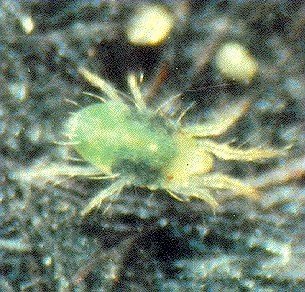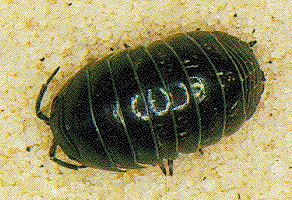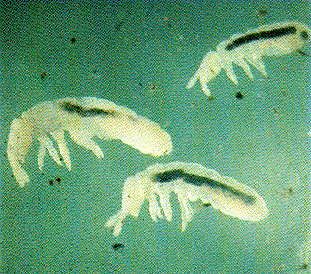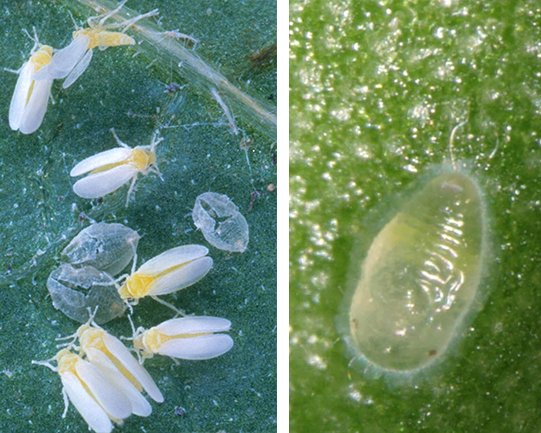Houseplant Insect Control
ENTFACT-406: Houseplant Insect Control | Download PDF
by Lee Townsend, Extension Entomologist
University of Kentucky College of Agriculture
Several kinds of insects or insect relatives can become pests of home or home greenhouse plants. Usually, it is easier to prevent pest problems than to cure them. Some preventive measures to consider are listed below:
How to Avoid Problems
Buy only healthy plants from certified nursery dealers. The chance of buying infested plants that may appear healthy at the time is greater when buying plants of uncertain origin.
- Always keep new plants isolated from other plants for 30 days to be sure they are not harboring pests.
- When re-potting, thinning out or otherwise handling your plants, do not move from one group of plants to the next without washing your hands and utensils. Microscopic stages of insects and disease organisms can be spread this way.
- When re-potting plants, use commercially prepared sterile soil rather than untreated soil from the yard or garden. Untreated soil can contain insects, mites, weed seeds or plant diseases.
- Inspect your plants regularly for signs of infestations. If a plant begins to show signs of a problem, isolate it from nearby plants until you can determine that the condition is not contagious.
If you discover insect infestations, there are several courses you can take. What you can do will depend on the kind of insect involved, the degree of infestation, the kind of plant involved and its value to you. These are some of the control techniques.
Control Alternatives
- Disposal- Easily replaced plants that are severely infested should be discarded rather than attempting to nurse them back to health. Even if they can eventually recover, the hazard of the infestation spreading to more valuable plants in the meantime is not worth the risk of keeping the plant.
- Pruning- Leaves, fronds and stems that are so heavily infested that these parts are dead or dying are best pruned away. The amount of pruning necessary to reduce an infestation will be determined in part by the kind of plant involved. Those with good regenerative ability may be very severely pruned while other plants may be permanently disfigured by only moderate pruning.
- Handpicking- Occasionally, large insect such as caterpillars, grasshoppers or beetles will get indoors in small numbers and quickly create noticeable damage. Handpicking the pests as they are found is usually simpler and more effective than other control techniques.
- Alcohol swabbing- A cotton ball or cotton swab dipped in rubbing alcohol can be used to wipe off aphids and mites. The alcohol has some insecticidal effect on the insects that may not get picked up on the swab.
- Pressure spraying- Aphids, mites, mealybugs, or thrips often can be removed or greatly reduced with a brisk water spray. The water pressure should be strong enough to knock the insects off but too weak to damage the plants. Repeat if necessary or use another method if results are not satisfactory.
- Washing- Broadleaved plants can be washed with soapy water and a soft brush or cloth to remove or kill scales, aphids, mealybugs, or other tiny insects that stay on the plant constantly. Use one teaspoon of mild detergent or soap in a gallon of water. Although this method is time consuming, it may be the best alternative to insecticide sprays which may injure the plant. Washing will have to be repeated if the infestation reappears. A thorough washing often holds scale infestations at bay for several months.
- Dipping- This is a modification of washing except that plants with finer foliage can be treated. Select a container large enough to accommodate the largest plant to be dipped. Only the above ground parts of the plant are dipped. When dipping, turn the plant upside down using crumpled paper or a cardboard disc to keep the plant of water.
- Hot water dipping- This method is specifically for treating African violets infested with cyclamen mites. Badly injured plant parts should be trimmed off where practical before dipping. The infested plant, pot and all, is immersed for 15 minutes in water held at 110 degrees F. Success of the treatment depends on careful control of the water temperature.
- Insecticide Spray- Only a few insecticide products including insecticidal soaps, are available for treating plants inside the home, and even some of these may injure certain plants. Read the label thoroughly before you buy or use a product to be sure it is appropriate for your situation. Most of the houseplant insecticide products are ready-to-use pressurized aerosols or finger-pump atomizers. They are generally safe to a wide variety of plants but sometimes injury will occur if the applicator is held too close to the plant. During good weather when plants can be taken outdoors for spraying, a wider choice of insecticides is available. However, the same precautions for selecting an appropriate product pertain. Do not move sprayed plants back indoors until the spray has thoroughly dried on the plants.
COMMON PESTS
Ants
1/16inch to 1/2 inch long black, brown or red insects. They can live in nests or colonies in flower beds, window boxes, flower pots or under greenhouse walks. Ants are attracted to aphids, scales or mealybugs that produce honeydew. Ants will dig up and carry away seeds and seedlings. Repot in a potting media. Be careful to keep ants from transferring in the process. Control of ants, scales or mealybugs on plants also is helpful.
Aphids
Aphids are sucking insects with soft, rounded bodies. They range from 1/12 inch to 1/8 inch long and their color may vary. They occur in clusters on buds or new foliage. Aphids suck sap, causing reduced growth or stunting of the plant. Feeding by some species may produce distorted leaves. Aphids secrete "honeydew" which gives the leaves a shiny appearance. A black sooty mold may grow on the honeydew. Dip, spray, alcohol swabbing, or washing can reduce infestations.
Fungus gnats
Fungus gnats are slender, delicate, mosquito-like flies. The larval stage is a small, active, thread-like white worm with a black head. The larvae live in damp soil and can damage small roots. Plants may drop leaves and generally lose vigor and color. Isolate infested plants. Insecticide sprays will kill adults. Allowing soil to dry more between waterings should help to control the larvae.
Mealybugs
Mealybugs are soft-bodied sucking insects that are covered with white, powdery wax filaments. They occur in leaf axils or branch crotches. Mealybugs suck plant sap and produce honeydew and produce symptoms like those from aphid infestations. Isolate infested plants and treat as for aphids.
Millipedes
Millipedes are worm-like hardbodied creatures with 2 pairs of legs on each body segment. They may coil into a circle when disturbed. They hide under boards, flower pots, and other sheltered areas that are damp. Millipedes usually feed on organic matter, but may attack roots, tubers, bulbs, and other fleshy plant parts. Eliminate hiding places and use a bait containing carbaryl (Sevin) or direct spray of insecticidal soap to control.
Cyclamen mites
Cyclamen mites are microscopic and almost transparent that infest african violets and cyclamen. They usually occur in protected places on tender growth. Leaves of infested plants are twisted and brittle and may turn black. The buds are deformed and often fail to open. Also, the flowers are deformed and may be streaked. Isolate infested plants and trim off or prune damaged parts. Hot water dipping may provide some control.

Spider Mites
Spider mites
Spider mites are very small and infestations may be overlooked until mites become very numerous or they begin to spin webbing on the plants. Mites remove sap from the plant, causing leaves to yellow and drop. Infested plants are stunted and unthrifty. Water sprays may be used to break up the webbing and reduce mite numbers. The plant foliage may be sprayed or dipped with insecticidal soaps. Be sure to treat the underside of the leaves. Treat at least two times, 10 days apart, to control newly-hatched mites. Mite eggs are not susceptible to insecticides.
Scales
Scales are stationary insects with shell-like coverings that protect their body. Some scales may be flat or convex, round, oval, or pear-shaped. Most are brown, but color can range from white to black. Scales produce honeydew, a substance that gives the leaves a shiny, sticky appearance. Sooty mold, a dark growth, may appear on the leaves of infested plants. Plants infested with scales show poor growth or are stunted. Spray or dip the foliage with a soapy wash. Repeat the treatment in 3 weeks and at intervals as needed.
Slugs
Slugs are fleshy, slimy animals. They may be light brown to black. Slugs rasp leaves, stems, flowers, or roots. Slugs may produce holes in the leaves or just scar the leaf surface. Silvery slime trails appear where they have crawled over surfaces. Slug baits containing metaldehyde may be used for control.
Sowbugs and Pillbugs
Sowbugs and Pillbugs are oval, hard-shelled, gray creatures that occur in damp places and hide under objects during the day. When disturbed, pillbugs curl up in to a small ball. Sowbugs run for cover. Both feed on decaying organic matter, but may attack rootlets and tender seedlings. Sevin may provide some control. These creatures require humid conditions in order to survive. Allowing the soil to dry more thoroughly should solve the problem.

Sowbug

Springtails
Springtails
Springtails range in size from microscopic to about 1/5 inch long. The color ranges from white to black; some can be blue or purple. They are able to jump and may float to the soil surface during watering. Springtails may chew seedlings or tender plant parts near the soil line. Allowing the soil to dry more thoroughly may help. Repot with potting soil mix and be careful not to transfer insects during the process.
Thrips
Thrips are slender insects that are barely visible to the naked eye. Color ranges from yellow, to tan, to brown or black. The younger stages are generally a lighter color than the adults. Thrips rasp leaves and suck sap from leaves and flowers. Injury appears as silvered areas that are speckled with dark fecal spots. The foliage may be blotchy and drop off. Flowers may be streaked, distorted, or fail to open. Infested plants can be dipped or sprayed.
Whiteflies
Whiteflies are about 1/16 inch long and resemble powdery white moths. The immature stages are similar to scales in appearance and feed on the underside of the leaves. They suck sap, causing leaves to turn pale and die or drop off. Sooty mold may develop on the honeydew that these insects produce. Dip or spray infested plants. Several treatments at weekly intervals may be needed.

Left: Silverleaf Whitefly Adults (Scott Bauer, USDA Agricultural Research Service, Bugwood.org)
Right: Sweetpotato Whitefly Nymph (Charles Olsen, USDA APHIS PPQ, Bugwood.org)
Revised: 7/19
CAUTION! Pesticide recommendations in this publication are registered for use in Kentucky, USA ONLY! The use of some products may not be legal in your state or country. Please check with your local county agent or regulatory official before using any pesticide mentioned in this publication.
Of course, ALWAYS READ AND FOLLOW LABEL DIRECTIONS FOR SAFE USE OF ANY PESTICIDE!
Images: University of Kentucky Entomology.
